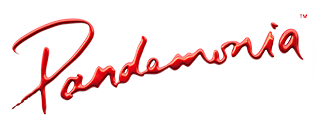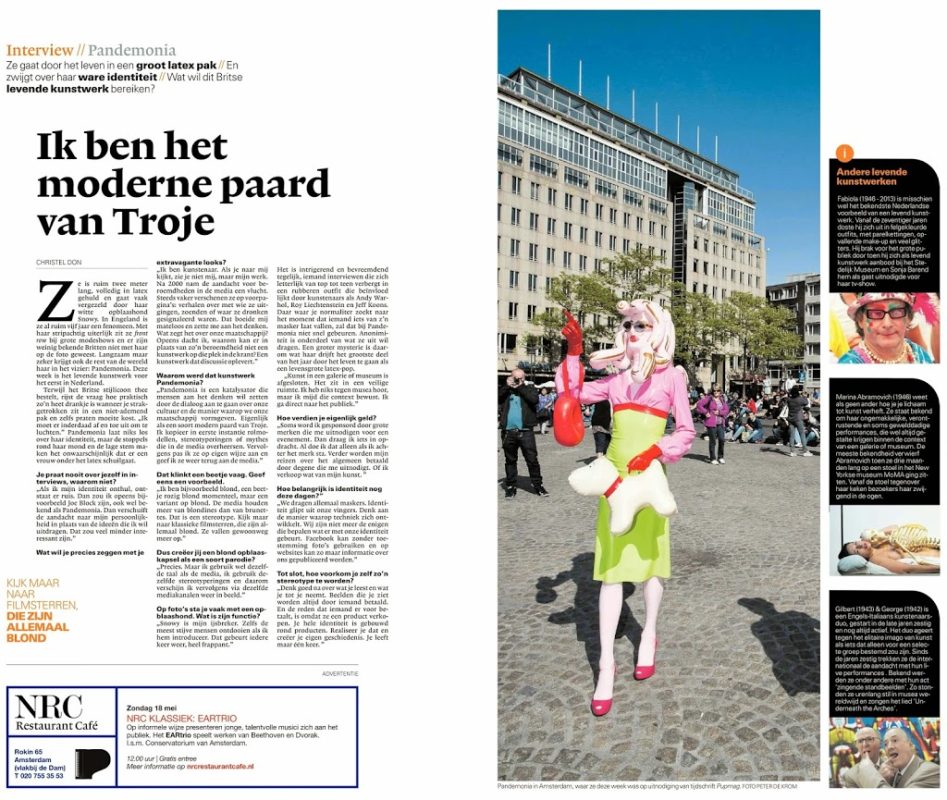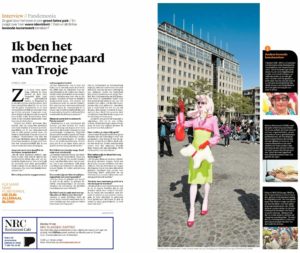NRC next interview by Christel Don
English Google translation
I am the modern Trojan horse
She goes through life in a large latex suit / / And give her true identity / / What do accomplish this British living work of art ?
Saturday, May 17, 2014
She is more than two meters long , fully dressed in latex , often accompanied by her white inflatable dog Snowy . In England they are more than five years, a phenomenon. With its cartoonish appearance she sits front row at fashion shows , and there are few famous Britons not been in the picture with her. Slowly but surely getting the rest of the world in its sights : Pandemonia . This week is a living work of art for the first time in the Netherlands .
While the British style icon orders tea, the question arises how practical such a hot drink when you tightened is in a non – breathable suit and even talking requires effort . “I have indeed occasionally to vent . ” Pandemonia have yet to comment about her identity , but the stubble around her mouth and deep voice make it unlikely that a woman hidden under the latex.
You never fail ? Talk about yourself in interviews, why
” If I reveal my identity , it creates noise. I would suddenly instance Joe Blogs are also known as Pandemonia . Then the focus shifts to my personality rather than the ideas that I want to convey. This would be much less interesting. ”
What exactly do you want to say with your extravagant looks ?
“I ‘m an artist . If you look at me , you will not see me , but my work . After 2000, the focus on celebrities in the media flight. Increasingly, they appeared on the front pages : stories about who they went out , kissed , or where they were spotted drunk . That fascinated me immensely and made me think . What does it say about our society ? Suddenly I thought, why can not there instead of some celebrity is not a work of art at that spot in the newspaper ? A work of art that produces discussion. ”
Why was that art Pandemonia ?
” Pandemonia is a catalyst that would continue to go about our culture and the way we shape our society . Dialogue people thinking Actually, as a kind of modern Trojan horse . I copy first role models , stereotypes and myths that dominate the media. Subsequently apply them in their own way and I give them back to the media . ”
That sounds a bit vague . Give an example .
” For example I am blond, slightly pinkish blond moment , but a variant of blonde. The media love blondes more than brunettes . That’s a stereotype . Just look at classic movie stars , who are all blond. They simply become more obvious . ”
So you create an inflatable blonde hair as a sort of parody ?
” Exactly . But I use the same language as the media , I use the same stereotypes , so I then appear through the same media channels back into the picture . ”
On the pictures you often find yourself with an inflatable dog . What is its function ?
” Snowy is my icebreaker. Even the most rigid people thaw when I introduce him . That again , happens every time very striking . ” It is intriguing and surprising at the same time , interview someone who hides literally from head to toe in a rubber outfit seems influenced by artists such as Andy Warhol , Roy Lichtenstein and Jeff Koons . Where you normally looks for the moment someone shows something of his mask fall , that will not happen quickly at Pandemonia . Anonymity is part of what she wants to wear out. A bigger mystery is why what drives it most of the year to go as a life-sized latex doll life.
” Art in a gallery or museum has been closed. It is in a safe area . I did not hear from museums , but I avoid that context aware . I go directly to the public. ”
How do you get money ?
” Sometimes I get sponsored by big brands who invite me to an event . I wear something commissioned . All I do that only if I ‘m behind the brand. Furthermore, my travels generally paid by the person inviting me . Or I sell some of my art . ”
How important is identity still these days ? ”
” We all wear masks . Identity slips from our fingers . Think of how technology evolves . We are not the only ones who decide what happens to our identity . Facebook can be used without permission and pictures on websites can be published so information about us . ”
Finally , how do you be such a stereotype ?
” Think carefully about what you read and what you consume . Images you see are always paid by someone . And the reason that someone pay for, because they sell a product . Your whole identity is built around products . Realize that and create your own history . You only live once . ”
Origional….Dutch
Ik ben het moderne paard van Troje
Ze gaat door het leven in een groot latex pak // En zwijgt over haar ware identiteit // Wat wil dit Britse levende kunstwerk bereiken? zaterdag 17 mei 2014
Ze is ruim twee meter lang, volledig in latex gehuld en gaat vaak vergezeld door haar witte opblaashond Snowy. In Engeland is ze al ruim vijf jaar een fenomeen. Met haar stripachtig uiterlijk zit ze front row bij grote modeshows en er zijn weinig bekende Britten níet met haar op de foto geweest. Langzaam maar zeker krijgt ook de rest van de wereld haar in het vizier: Pandemonia. Deze week is het levende kunstwerk voor het eerst in Nederland.
Terwijl het Britse stijlicoon thee bestelt, rijst de vraag hoe praktisch zo’n heet drankje is wanneer je strakgetrokken zit in een niet-ademend pak en zelfs praten moeite kost. „Ik moet er inderdaad af en toe uit om te luchten.” Pandemonia laat niks los over haar identiteit, maar de stoppels rond haar mond en de lage stem maken het onwaarschijnlijk dat er een vrouw onder het latex schuilgaat.
Je praat nooit over jezelf in interviews, waarom niet?
„Als ik mijn identiteit onthul, ontstaat er ruis. Dan zou ik opeens bijvoorbeeld Joe Block zijn, ook wel bekend als Pandemonia. Dan verschuift de aandacht naar mijn persoonlijkheid in plaats van de ideeën die ik wil uitdragen. Dat zou veel minder interessant zijn.”
Wat wil je precies zeggen met je extravagante looks?
„Ik ben kunstenaar. Als je naar mij kijkt, zie je niet mij, maar mijn werk. Na 2000 nam de aandacht voor beroemdheden in de media een vlucht. Steeds vaker verschenen ze op voorpagina’s: verhalen over met wie ze uitgingen, zoenden of waar ze dronken gesignaleerd waren. Dat boeide mij mateloos en zette me aan het denken. Wat zegt het over onze maatschappij? Opeens dacht ik, waarom kan er in plaats van zo’n beroemdheid niet een kunstwerk op die plek in de krant? Een kunstwerk dat discussie oplevert.”
Waarom werd dat kunstwerk Pandemonia?
„Pandemonia is een katalysator die mensen aan het denken wil zetten door de dialoog aan te gaan over onze cultuur en de manier waarop we onze maatschappij vormgeven. Eigenlijk als een soort modern paard van Troje. Ik kopieer in eerste instantie rolmodellen, stereotyperingen of mythes die in de media overheersen. Vervolgens pas ik ze op eigen wijze aan en geef ik ze weer terug aan de media.”
Dat klinkt een beetje vaag. Geef eens een voorbeeld.
„Ik ben bijvoorbeeld blond, een beetje rozig blond momenteel, maar een variant op blond. De media houden meer van blondines dan van brunettes. Dat is een stereotype. Kijk maar naar klassieke filmsterren, die zijn allemaal blond. Ze vallen gewoonweg meer op.”
Dus creëer jij een blond opblaaskapsel als een soort parodie?
„Precies. Maar ik gebruik wel dezelfde taal als de media, ik gebruik dezelfde stereotyperingen en daarom verschijn ik vervolgens via dezelfde mediakanalen weer in beeld.” Op foto’s sta je vaak met een opblaashond. Wat is zijn functie?
„Snowy is mijn ijsbreker. Zelfs de meest stijve mensen ontdooien als ik hem introduceer. Dat gebeurt iedere keer weer, heel frappant.” Het is intrigerend en bevreemdend tegelijk, iemand interviewen die zich letterlijk van top tot teen verbergt in een rubberen outfit die beïnvloed lijkt door kunstenaars als Andy Warhol, Roy Liechtenstein en Jeff Koons. Daar waar je normaliter zoekt naar het moment dat iemand iets van z’n masker laat vallen, zal dat bij Pandemonia niet snel gebeuren. Anonimiteit is onderdeel van wat ze uit wil dragen. Een groter mysterie is daarom wat haar drijft het grootste deel van het jaar door het leven te gaan als een levensgrote latex-pop. „Kunst in een galerie of museum is afgesloten. Het zit in een veilige ruimte. Ik heb niks tegen musea hoor, maar ik mijd die context bewust. Ik ga direct naar het publiek.” Hoe verdien je eigenlijk geld?
„Soms word ik gesponsord door grote merken die me uitnodigen voor een evenement. Dan draag ik iets in opdracht. Al doe ik dat alleen als ik achter het merk sta. Verder worden mijn reizen over het algemeen betaald door degene die me uitnodigt. Of ik verkoop wat van mijn kunst. ”
Hoe belangrijk is identiteit nog deze dagen?”
„We dragen allemaal maskers. Identiteit glipt uit onze vingers. Denk aan de manier waarop techniek zich ontwikkelt. Wij zijn niet meer de enigen die bepalen wat er met onze identiteit gebeurt. Facebook kan zonder toestemming foto’s gebruiken en op websites kan zo maar informatie over ons gepubliceerd worden.”
Tot slot, hoe voorkom je zelf zo’n stereotype te worden?
„Denk goed na over wat je leest en wat je tot je neemt. Beelden die je ziet worden altijd door iemand betaald. En de reden dat iemand er voor betaalt, is omdat ze een product verkopen. Je hele identiteit is gebouwd rond producten. Realiseer je dat en creëer je eigen geschiedenis. Je leeft maar één keer. ”


